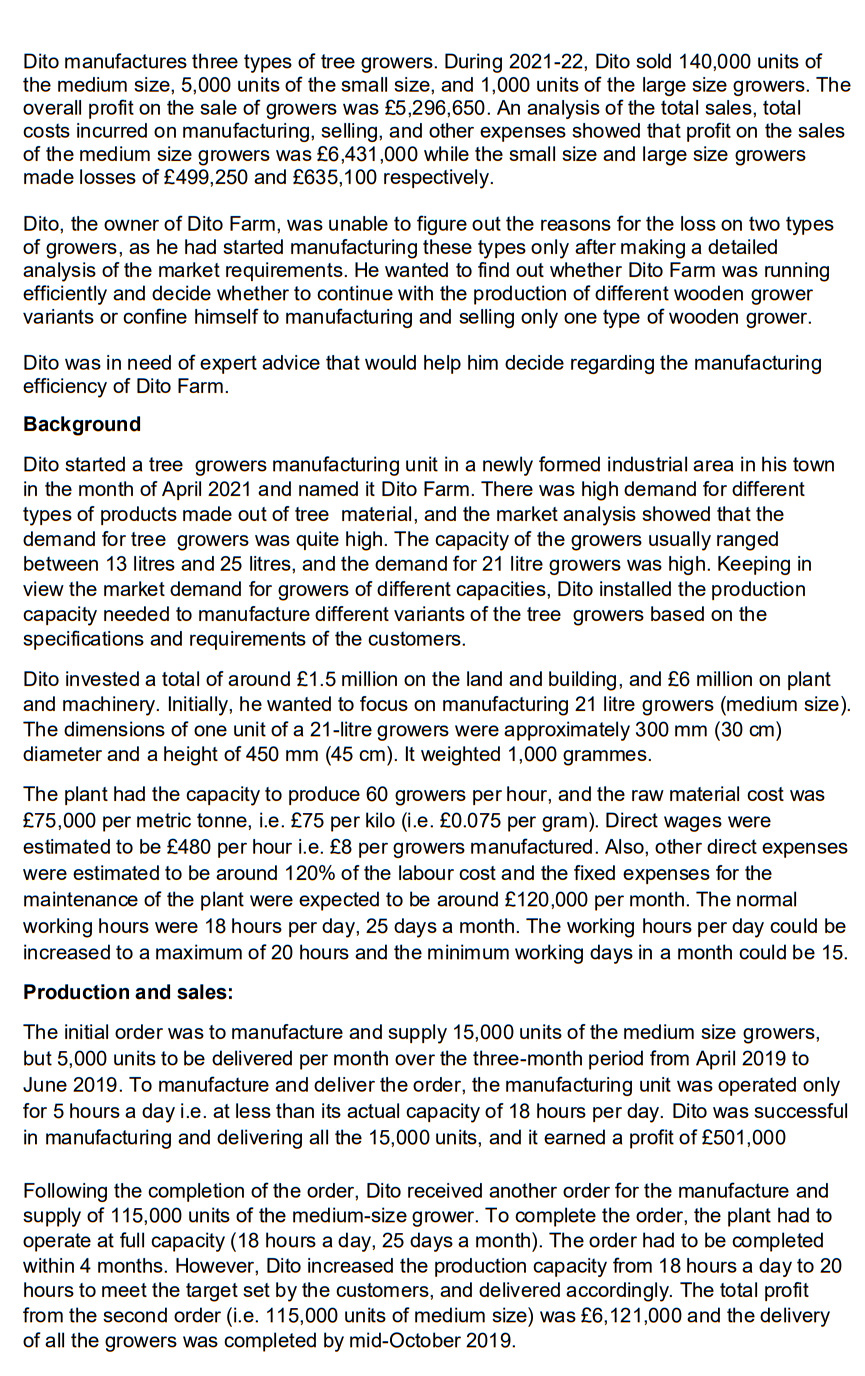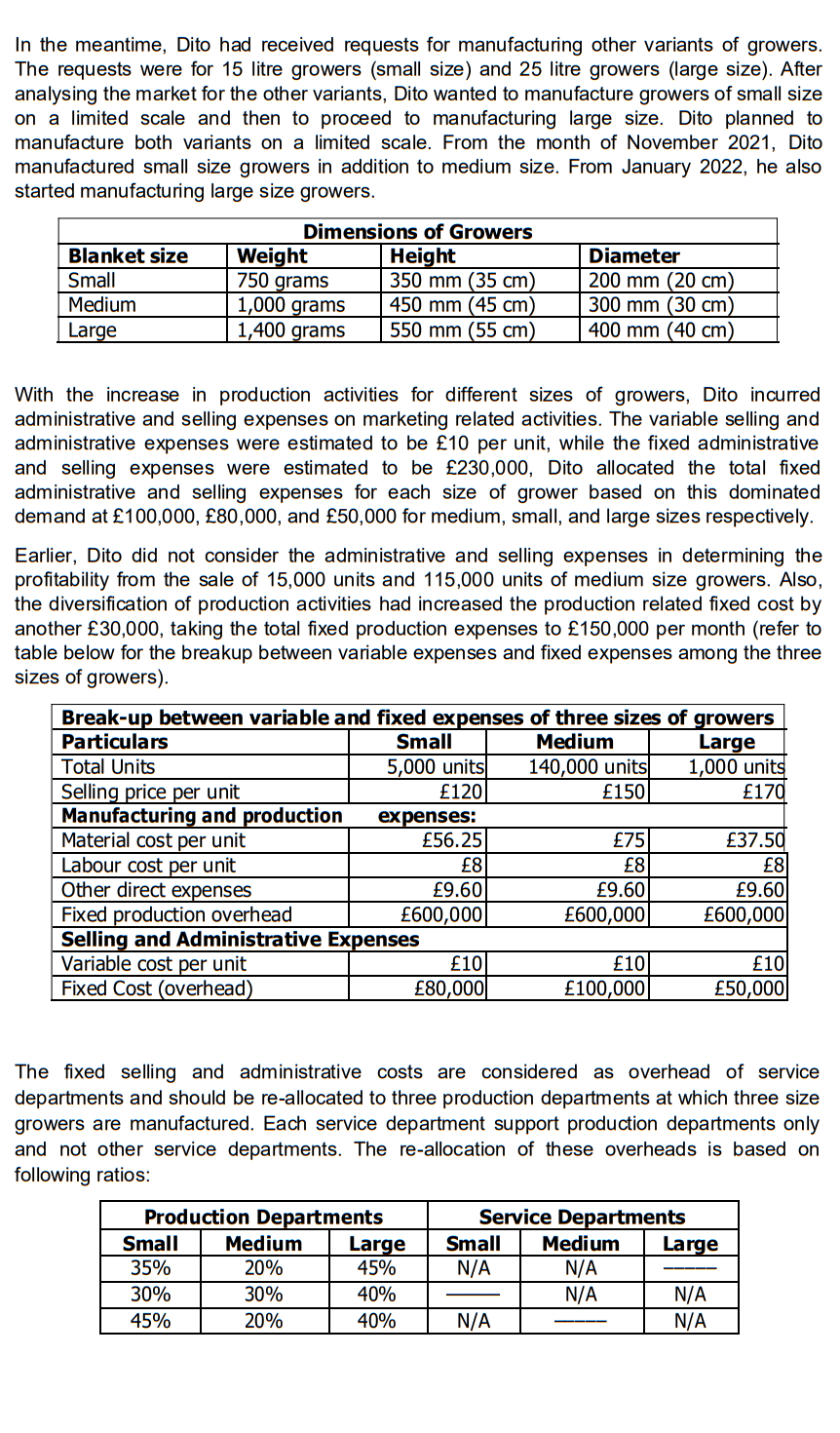Answered step by step
Verified Expert Solution
Question
1 Approved Answer
Calculate total cost and profit for each small, medium, and large grower order (in total and in units) based on absorption and marginal costing systems


Calculate total cost and profit for each small, medium, and large grower order (in total and in units) based on absorption and marginal costing systems and discuss Of the three sizes of growers manufactured and sold by Dito, two sizes (small and large) made losses. How has the manufacturing efficiency been impacted due to the losses? Using the appropriate costing approach, advise Dito on whether to continue with the production of small and large growers or stop the production of one or both sizes
Dito manufactures three types of tree growers. During 2021-22, Dito sold 140,000 units of the medium size, 5,000 units of the small size, and 1,000 units of the large size growers. The overall profit on the sale of growers was 5,296,650. An analysis of the total sales, total costs incurred on manufacturing, selling, and other expenses showed that profit on the sales of the medium size growers was 6,431,000 while the small size and large size growers made losses of 499,250 and 635,100 respectively. Dito, the owner of Dito Farm, was unable to figure out the reasons for the loss on two types of growers, as he had started manufacturing these types only after making a detailed analysis of the market requirements. He wanted to find out whether Dito Farm was running efficiently and decide whether to continue with the production of different wooden grower variants or confine himself to manufacturing and selling only one type of wooden grower. Dito was in need of expert advice that would help him decide regarding the manufacturing efficiency of Dito Farm. Background Dito started a tree growers manufacturing unit in a newly formed industrial area in his town in the month of April 2021 and named it Dito Farm. There was high demand for different types of products made out of tree material, and the market analysis showed that the demand for tree growers was quite high. The capacity of the growers usually ranged between 13 litres and 25 litres, and the demand for 21 litre growers was high. Keeping in view the market demand for growers of different capacities, Dito installed the production capacity needed to manufacture different variants of the tree growers based on the specifications and requirements of the customers. Dito invested a total of around 1.5 million on the land and building, and 6 million on plant and machinery. Initially, he wanted to focus on manufacturing 21 litre growers (medium size). The dimensions of one unit of a 21-litre growers were approximately 300 mm (30 cm) diameter and a height of 450 mm (45 cm). It weighted 1,000 grammes. The plant had the capacity to produce 60 growers per hour, and the raw material cost was 75,000 per metric tonne, i.e. 75 per kilo (i.e. 0.075 per gram). Direct wages were estimated to be 480 per hour i.e. 8 per growers manufactured. Also, other direct expenses were estimated to be around 120% of the labour cost and the fixed expenses for the maintenance of the plant were expected to be around 120,000 per month. The normal working hours were 18 hours per day, 25 days a month. The working hours per day could be increased to a maximum of 20 hours and the minimum working days in a month could be 15. Production and sales: The initial order was to manufacture and supply 15,000 units of the medium size growers, but 5,000 units to be delivered per month over the three-month period from April 2019 to June 2019. To manufacture and deliver the order, the manufacturing unit was operated only for 5 hours a day i.e. at less than its actual capacity of 18 hours per day. Dito was successful in manufacturing and delivering all the 15,000 units, and it earned a profit of 501,000 Following the completion of the order, Dito received another order for the manufacture and supply of 115,000 units of the medium-size grower. To complete the order, the plant had to operate at full capacity (18 hours a day, 25 days a month). The order had to be completed within 4 months. However, Dito increased the production capacity from 18 hours a day to 20 hours to meet the target set by the customers, and delivered accordingly. The total profit from the second order (i.e. 115,000 units of medium size) was 6,121,000 and the delivery of all the growers was completed by mid-October 2019. In the meantime, Dito had received requests for manufacturing other variants of growers. The requests were for 15 litre growers (small size) and 25 litre growers (large size). After analysing the market for the other variants, Dito wanted to manufacture growers of small size on a limited scale and then to proceed to manufacturing large size. Dito planned to manufacture both variants on a limited scale. From the month of November 2021, Dito manufactured small size growers in addition to medium size. From January 2022, he also started manufacturing large size growers. Blanket size Small Medium Large Dimensions of Growers Weight Height 750 grams 350 mm (35 cm) 1,000 grams 450 mm (45 cm) 1,400 grams 550 mm (55 cm) Diameter 200 mm (20 cm) 300 mm (30 cm) 400 mm (40 cm) With the increase in production activities for different sizes of growers, Dito incurred administrative and selling expenses on marketing related activities. The variable selling and administrative expenses were estimated to be 10 per unit, while the fixed administrative and selling expenses were estimated to be 230,000, Dito allocated the total fixed administrative and selling expenses for each size of grower based on this dominated demand at 100,000, 80,000, and 50,000 for medium, small, and large sizes respectively. Earlier, Dito did not consider the administrative and selling expenses in determining the profitability from the sale of 15,000 units and 115,000 units of medium size growers. Also, the diversification of production activities had increased the production related fixed cost by another 30,000, taking the total fixed production expenses to 150,000 per month (refer to table below for the breakup between variable expenses and fixed expenses among the three sizes of growers). Break-up between variable and fixed expenses of three sizes of growers Particulars Small Medium Large Total Units 5,000 units 140,000 units 1,000 units Selling price per unit 120 150 170 Manufacturing and production expenses: Material cost per unit 56.25 75 37.50 Labour cost per unit 8 8 8 Other direct expenses 9.60 9.60 9.60 Fixed production overhead 600,000 600,000 600,000 Selling and Administrative Expenses Variable cost per unit 10 10 10 Fixed Cost (overhead) 80,000 100,000 50,000 The fixed selling and administrative costs are considered as overhead of service departments and should be re-allocated to three production departments at which three size growers are manufactured. Each service department support production departments only and not other service departments. The re-allocation of these overheads is based on following ratios: Production Departments Small Medium Large 35% 20% 30% 30% 40% 45% 20% 40% 45% Service Departments Small Medium Large N/A N/A N/A N/A N/A N/AStep by Step Solution
There are 3 Steps involved in it
Step: 1

Get Instant Access to Expert-Tailored Solutions
See step-by-step solutions with expert insights and AI powered tools for academic success
Step: 2

Step: 3

Ace Your Homework with AI
Get the answers you need in no time with our AI-driven, step-by-step assistance
Get Started


